In the charming state of Maryland, a mesmerizing world of tiny, colorful hummingbirds awaits you. These enchanting birds are a common sight, with Ruby-throated Hummingbirds and Rufous Hummingbirds being the stars of the show. These avian acrobats add a touch of magic to your garden. They aren’t just fascinating to watch; they also play an essential role in pollination. In this article, we will take you on a journey through the hummingbirds you can find in Maryland and how to attract them to your garden.
How Many Hummingbirds in Maryland?
1. Allen’s Hummingbird
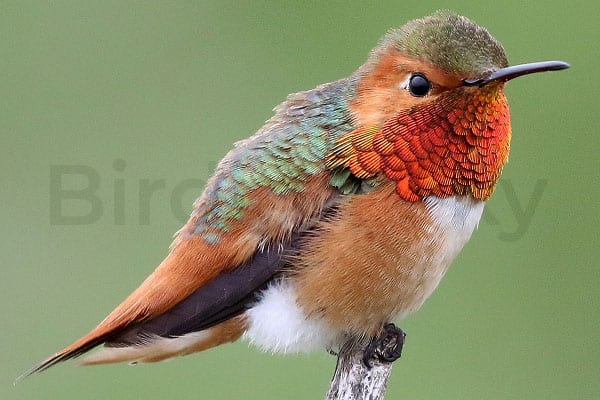
Description:
- Appearance: The male Allen’s Hummingbird has a striking orange-red throat and a green back with a metallic sheen. The female is relatively duller with a greenish throat and white underparts.
- Size: They are one of the smaller hummingbirds, measuring around 3.5 inches in length.
- Habitat: These birds can be found in wooded and shrubby areas, often close to coastal regions.
- Migration: They are mostly migratory birds, so you can spot them during specific times of the year.
Additional Information:
- Diet: Allen’s Hummingbirds primarily feed on nectar from brightly colored, tubular flowers.
- Interesting Fact: They are known for their distinctive “dive display,” where males plummet from great heights before pulling up at the last moment to produce a high-pitched noise.
2. Ruby-throated hummingbirds
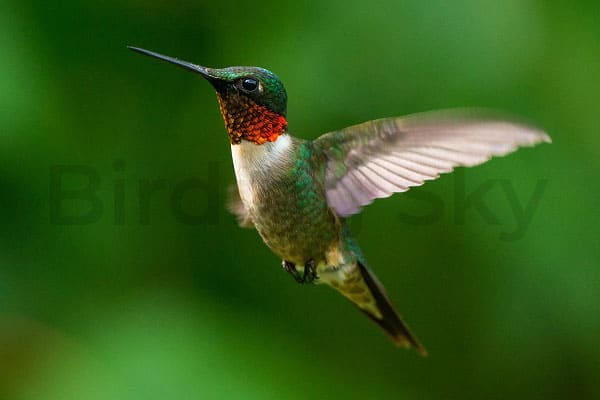
Description:
- Appearance: The male Ruby-throated Hummingbird has a striking orange-red throat and a green back with a metallic sheen. The female is relatively duller with a greenish throat and white underparts.
- Size: They are one of the smaller hummingbirds, measuring around 3.5 inches in length.
- Habitat: These birds can be found in wooded and shrubby habitats, often close to coastal regions.
- Migration: They are mostly migratory birds, so you can spot them during specific times of the year.
Additional Information:
- Diet: Ruby-throated Hummingbirds primarily feed on nectar from brightly colored, tubular flowers.
- Interesting Fact: They are known for their distinctive “dive display,” where males plummet from great heights before pulling up at the last moment to produce a high-pitched noise.
Related Article: Beautiful Hummingbird Species
3. Rufous Hummingbirds

Description:
- Appearance: Rufous Hummingbirds are known for their rusty-orange plumage, which covers most of their bodies. Males have bright orange throats.
- Size: They are small birds, measuring around 3.5 inches.
- Habitat: They are commonly found in the western parts of Maryland, often in forested and shrubby areas.
- Migration: Rufous Hummingbirds are migratory, so they visit Maryland during specific times of the year.
Additional Information:
- Diet: Their diet includes nectar and small insects.
- Interesting Fact: Rufous Hummingbirds are known for their impressive annual migration, traveling over 2,000 miles.
Must Visit: When do Bluebirds Nest in Florida?
4. Black-Chinned Hummingbird
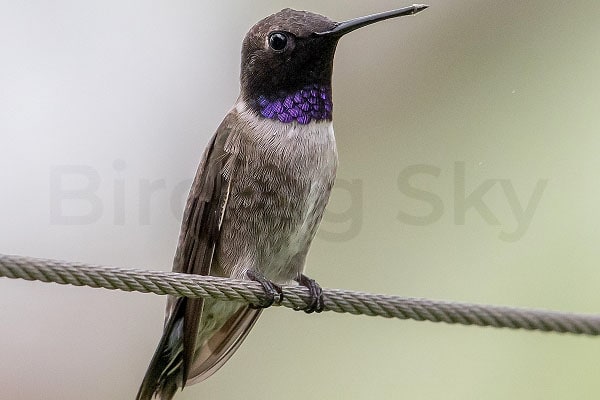
Description:
- Appearance: These hummingbirds have distinctive iridescent purple or black throats. Their upperparts are green, and their undersides are white.
- Size: They are small birds, measuring around 3.5 inches in length.
- Habitat: Black-chinned Hummingbirds prefer open woodlands, desert areas, and gardens.
- Migration: They are migratory birds, so you can expect to see them during specific seasons.
Additional Information:
- Diet: Their diet primarily consists of nectar from various flower species.
- Interesting Fact: Black-chinned Hummingbirds are known for their aerial combat displays, defending their territories fiercely.
5. Calliope Hummingbird

Description:
- Appearance: Calliope Hummingbirds have striking magenta throats with greenish backs. They are the smallest hummingbirds in North America.
- Size: These tiny birds measure around 3 inches in length.
- Habitat: They can be found in mountainous areas, particularly near streams and meadows.
- Migration: Calliope Hummingbirds are migratory birds, so they visit Maryland during specific seasons.
Additional Information:
- Diet: Their primary food source is nectar, but they also consume insects for protein.
- Interesting Fact: Calliope Hummingbirds are known for their distinctive high-pitched “zip” call.
You May Want to Read: Why Chickens In Key West?
6. Mexican Violetear
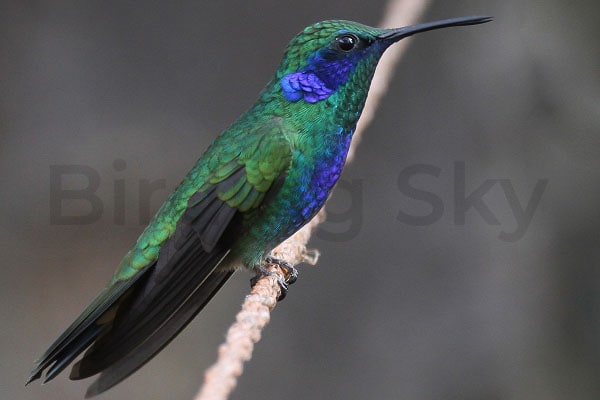
Description:
- Appearance: Mexican Violetears are large, with deep green feathers and a violet-blue band across their throats.
- Size: They are relatively larger, measuring around 4 inches in length.
- Habitat: While they are not commonly seen in Maryland, these hummingbirds can be spotted in lush, subtropical environments.
- Migration: Their presence in Maryland is rare, as they are mostly found in Central America.
Additional Information:
- Diet: Mexican Violetears feed on nectar, insects, and spiders.
- Interesting Fact: They are known for their distinctive “whistle” calls.
Also Read: Blue Jay Eggs
7. Anna’s Hummingbird
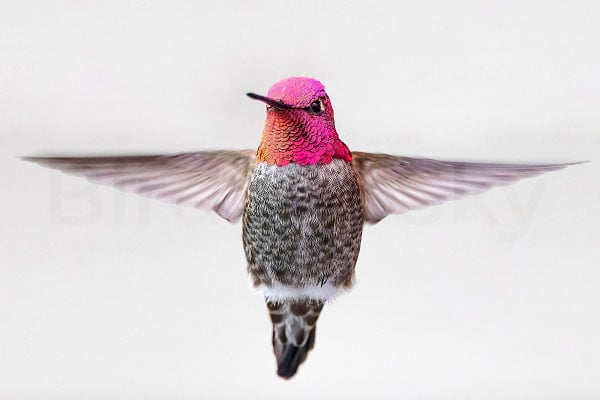
Description:
- Appearance: Anna’s Hummingbirds are known for their iridescent emerald-green feathers and striking pink throats. Males have a more vibrant coloration than females.
- Size: They are relatively larger than other hummingbird species, measuring around 4 inches.
- Habitat: These birds are year-round residents in Maryland, often found in urban and suburban areas.
- Migration: Anna’s Hummingbirds are non-migratory and can be spotted throughout the year.
Additional Information:
- Diet: Their diet includes a mix of nectar, insects, and spiders.
- Interesting Fact: Anna’s Hummingbirds are one of the few species that can sing during their rapid flight, producing a series of squeaky chirps.
Frequently Asked Questions
Q-1: What months are hummingbirds in Maryland?
Hummingbirds are typically present in Maryland from late March to early October. They migrate to the region in the spring and depart in the fall.
Q-2: Are there hummingbirds in Maryland?
Yes, Maryland is home to several species of hummingbirds, making it an ideal location for bird enthusiasts to spot these tiny wonders.
Q-3: How many species of hummingbirds are in Maryland?
Maryland is visited by several species of hummingbirds, including the Ruby-throated Hummingbird, Rufous Hummingbird, Anna’s Hummingbird, and more. Each species has its own unique characteristics.
Q-4: How do you attract hummingbirds in Maryland?
To attract hummingbirds in Maryland, you can plant nectar-rich flowers, set up hummingbird feeders, and provide a safe and inviting environment for them. Ensure your garden has a variety of flowers that bloom at different times to provide a consistent nectar source.
Q-5: When should I stop feeding hummingbirds in my area?
You should stop feeding hummingbirds in Maryland in early to mid-October when they begin their migration to warmer regions. Continuing to feed them beyond this period may disrupt their natural instincts to migrate.
Final Remarks:
In Maryland, the presence of hummingbirds adds a touch of enchantment to the natural world. By learning about the different species and their unique characteristics, you can better appreciate these tiny wonders. Whether you’re a bird enthusiast or simply looking to enhance your garden’s beauty, attracting hummingbirds can be a rewarding experience.
Now that you know the various species that grace Maryland with their presence, you can create a hummingbird-friendly haven in your own backyard. Planting nectar-rich flowers, setting up feeders, and providing a safe environment can make your garden an irresistible stop for these delightful creatures.
So, prepare to be amazed by the beauty and grace of Maryland’shummingbirds. They may be small, but they leave a big impact on anyone lucky enough to witness them in action.
